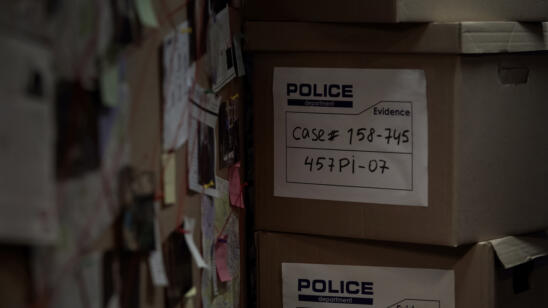It’s been nearly 10 years since Sandra Denise Thomas left a house party near her home in Fuquay-Varina, North Carolina, and was last seen alive about 2 a.m., walking alone down a nearby road.
The next morning, a passerby found the 41-year-old mother’s body in a ditch not far away. The many injuries to her arms, legs, head and torso were consistent with being thrown or dragged from a moving vehicle, the medical examiner said.
At the time, police in Fuquay-Varina, a town of about 27,000 outside of Raleigh, investigated the case: They interviewed witnesses, spoke to Thomas’s friends and family members and collected evidence. They offered a $5,000 reward for information leading to a conviction in the case. But there wasn’t enough to establish probable cause for an arrest. As the Fuquay-Varina Police Department later wrote on its Facebook page: “All leads were pursued. A cocoon of silence enveloped the streets and the case went cold.”
The case thawed a bit in 2019. Police obtained a search warrant to compare paint samples from a 1988 Chevy pickup truck with paint found on Thomas’s clothing and to search the truck for her DNA. The owner had told police that Thomas called him the night of her death and that they planned to meet; but when she didn’t arrive, he fell asleep.
Later that year, North Carolina Gov. Roy Cooper increased the reward for information in the case to $10,000.
The Case Has Stalled
Now, two years later, all Fuquay-Varina police will say about Thomas’s death is that they have submitted evidence to an independent lab and are awaiting results.
“It’s sure frustrating,” Gladys Holland, Thomas’s mother, told A&E True Crime. “They told me they would let me know something. That was last June. I haven’t heard anything since.”
The FVPD has increased efforts to crack the 2011 cold case—particularly since Laura Fahnestock took over as chief in 2015.
[Watch Cold Case Files Classic on A&E Crime Central.
In her previous post with the Rocky Mount, North Carolina, police department, Fahnestock established a cold case unit that solved two cases in its first year of operation. In Fuquay-Varina, she had the department’s Investigative Division focus again on Thomas’s murder and develop strategies to move the department’s only cold case forward. According to the FVPD’s Facebook page, investigators consulted various state and local agencies and attended training sessions in homicide and evidence techniques.
“Our goal is to solve this case by following the truth, the facts and the evidence. By doing so, we will continue our work to bring justice for the family of Sandra Denise Thomas,” says a FVPD statement on Facebook. “We may not solve the case today, but we will never give up. Sandra deserves justice. Someone knows something about this case and it is time to come forward.”
New Advances in DNA Analysis Could Help
Among the resources, Fuquay-Varina police consulted was the Carolina Cold Case Coalition, a nonprofit organization of mostly retired local, state and federal law enforcement officers with extensive experience investigating unsolved crimes. Coalition founder Joe D. Kennedy, who also founded the cold case unit at the Naval Criminal Investigative Services (NCIS), declined to discuss specifics in the Thomas case with A&E True Crime—) that’s the group’s agreement with the police departments they assist—but Kennedy did say, “We’re able to do things in the last three or four years that we weren’t able to do before. It’s amazing what’s going on now.”
According to Kennedy, the biggest game-changer is DNA analysis. When it was new in the late 1980s, technicians needed samples of blood, saliva or semen the size of a quarter to analyze. Now, they can extract information from samples as small as 20 nanograms. “One grain of salt is 58,000 nanograms,” Kennedy says.
Advanced labs can also amplify DNA that was degraded by sunlight or other elements before samples could be collected. Even DNA that was extracted decades ago can lead to convictions today.
Investigators can also cast wider searches for DNA matches than ever before.
Crime labs have traditionally focused on DNA found on the Y chromosome, which is passed along from fathers to sons. (Statistically, most perpetrators of serious crimes are male.) Now analysts can also track mitochondrial DNA, which mothers pass to sons and daughters, and autosomal DNA found on all 23 pairs of chromosomes. Paired with genealogical records that include DNA samples, investigators can create extensive family trees based on tiny fragments of genetic material.
Such forensic genealogy is what finally identified Joseph James DeAngelo, a former police officer, as the Golden State Killer who committed scores of rapes, murders and robberies in California between 1973 and 1986.
Still, Kennedy says many state and local crime labs don’t have such advanced DNA capabilities, so police have to send samples to independent (and often costly) labs for analysis. And, he adds, “it’s not unheard of for labs to take an inordinate amount of time” to return results.
Rumors Remain
For now, both police and Thomas’s family continue to wait and hope for a resolution in the case.
Holland says she has heard plenty of rumors about murder and passed them along to police.
“Somebody said she had gotten into a fight with a lady, and the lady said she was ‘gonna get her,'” she says. “Then there was another guy who was making these threats towards girls, saying ‘I’ll do you like I did her.’ Everybody around town was saying it was him, but there was never an arrest.”
Holland also says Thomas was in and out of rehab several times. “Each time she would straighten herself out, her old friends would pull her right back out there,” she says. “But she was trying to lead a good life. She had a 10-year old son, and she was living for him.”
“I don’t care who you talk to—they’ll all say the same thing,” adds Holland, who raised her grandson after his mother’s death. Sandra “loved everybody. She loved taking care of old people and babies. She never walked away from anybody without telling them she loved them. We need some closure. Her son needs some closure. There’s not one day that goes by that I don’t miss her. Not one day.”
Related Features:
How Chicago Is Trying to Solve 51 Strangulation Homicides of Women
The West Mesa Murders: Is the ‘West Mesa Bone Collector’ Serial Killer Still Roaming Free?
The Burger Chef Cold Case: Four Murders Still Unsolved Over 40 Years Later


